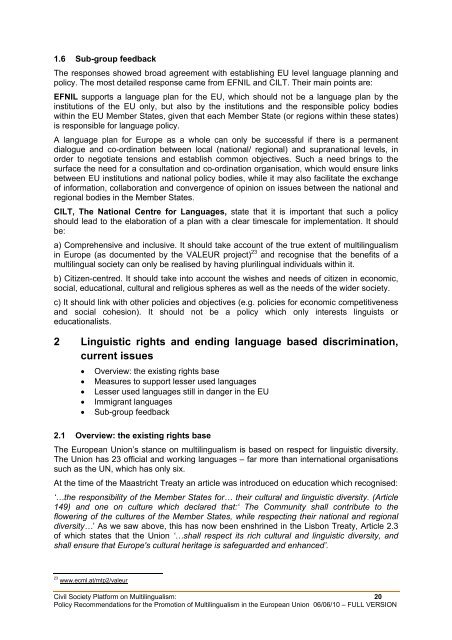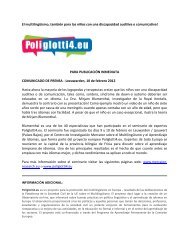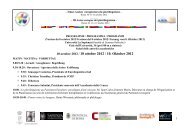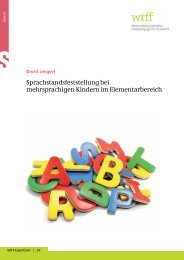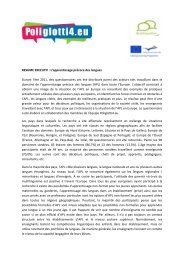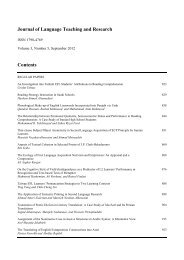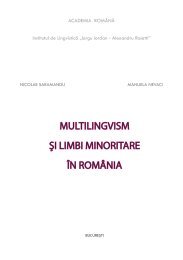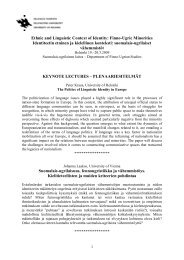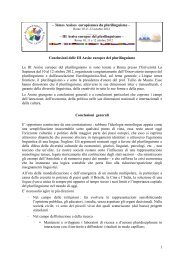1.6 Sub-group feedbackThe responses showed broad agreement with establishing EU level language planning andpolicy. The most detailed response came from EFNIL and CILT. Their main points are:EFNIL supports a language plan for the EU, which should not be a language plan by theinstitutions of the EU only, but also by the institutions and the responsible policy bodieswithin the EU Member States, given that each Member State (or regions within these states)is responsible for language policy.A language plan for Europe as a whole can only be successful if there is a permanentdialogue and co-ordination between local (national/ regional) and supranational levels, inorder to negotiate tensions and establish common objectives. Such a need brings to thesurface the need for a consultation and co-ordination organisation, which would ensure linksbetween EU institutions and national policy bodies, while it may also facilitate the exchangeof information, collaboration and convergence of opinion on issues between the national andregional bodies in the Member States.CILT, The National Centre for Languages, state that it is important that such a policyshould lead to the elaboration of a plan with a clear timescale for implementation. It shouldbe:a) Comprehensive and inclusive. It should take account of the true extent of multilingualismin Europe (as documented by the VALEUR project) 23 and recognise that the benefits of amultilingual society can only be realised by having plurilingual individuals within it.b) Citizen-centred. It should take into account the wishes and needs of citizen in economic,social, educational, cultural and religious spheres as well as the needs of the wider society.c) It should link with other policies and objectives (e.g. policies for economic competitivenessand social cohesion). It should not be a policy which only interests linguists oreducationalists.2 Linguistic rights and ending language based discrimination,current issuesOverview: the existing rights baseMeasures to support lesser used languagesLesser used languages still in danger in the EUImmigrant languagesSub-group feedback2.1 Overview: the existing rights baseThe <strong>European</strong> Union’s stance on multilingualism is based on respect for linguistic diversity.The Union has 23 official and working languages – far more than international organisationssuch as the UN, which has only six.At the time of the Maastricht Treaty an article was introduced on education which recognised:‘…the responsibility of the Member States for… their cultural and linguistic diversity. (Article149) and one on culture which declared that:‘ The Community shall contribute to theflowering of the cultures of the Member States, while respecting their national and regionaldiversity…’ As we saw above, this has now been enshrined in the Lisbon Treaty, Article 2.3of which states that the Union ‘…shall respect its rich cultural and linguistic diversity, andshall ensure that Europe's cultural heritage is safeguarded and enhanced’.23www.ecml.at/mtp2/valeurCivil Society Platform on Multilingualism: 20Policy Recommendations for the Promotion of Multilingualism in the <strong>European</strong> Union 06/06/10 – <strong>FULL</strong> <strong>VERSION</strong>
A similar provision can be found in Article 22 of the Charter of Fundamental Rights whichaccompanies the Treaty: Cultural, religious and linguistic diversity The Union shall respectcultural, religious and linguistic diversity.In short, the Union has a moral and legal imperative to respect and promote linguistic andcultural diversity.Lisbon Treaty and a new ‘human rights architecture’The Lisbon Treaty and the accompanying Charter of Fundamental Rights which came intoforce on 1 December 2009 acted to embed linguistic diversity as a <strong>European</strong> value.Charter for Fundamental Rights (CFR)The discrimination prohibition of Article 21 of the CFR 24 has already been mentioned. Whilethe Charter’s competence is only operative when states implement EU law and whennational legislation transposes EU law, it marks a step forward because it sets out the EUstandard and expectations on this issue. It makes the CFR the benchmark in the treatment oflanguages and national minorities.<strong>European</strong> Convention on Human Rights (ECHR)The accession of the EU to the ECHR, currently under negotiation, will further augmentlanguage and national minority rights (e.g. Article 14). Taking the new treaties together thecurrent term in the <strong>European</strong> Parliament is of a ‘new architecture’ to <strong>European</strong> human rightsand of Europe-wide standards of rights.Council of Europe ECRML and the FCNMThe two Council of Europe treaties concerning languages are the <strong>European</strong> Charter forRegional or Minority Languages (ECRML) and the Framework Convention for the Protectionof National Minorities (FCNM). Together these treaties set the standard for RML protection inthe EU.2.2 Measures to support lesser used languagesContributor Dónall Ó Riagáin (Abakan Action) comments: “Thanks to the efforts of <strong>European</strong>Parliamentarians in the late 70s and early 80s, especially Gaetano Arfé MEP and JohnHume MEP, resolutions were passed in the <strong>European</strong> Parliament which led to theestablishment of a dedicated budget line to support lesser used languages – Budget Line B3-1006, the establishment of the <strong>European</strong> Bureau for Lesser Used Languages [EBLUL] andthe Intergroup for Minority Languages, now known as the <strong>European</strong> Parliament Intergroup forTraditional Minorities, National Communities and Languages. Many positive actions flowedfrom these developments e.g. exchanges of information and expertise among RML groups,joint projects, study visits, pilot schemes and a raising of awareness of linguistic rights acrossEurope. Above all, it led to a sense of solidarity among users of these languages.Undoubtedly, the development of the <strong>European</strong> Charter for Regional or Minority Languageswas another by-product.“Unfortunately, the judgement of the ECJ on Case C-106/96United Kingdom and others v.<strong>Commission</strong> [1998] ECR 1-2729 AT 2755, para. 26 ended this progressive period. Theresponse of <strong>Commission</strong>er Viviane Reding was to ‘mainstream’ all languages in EUprogrammes. Hence, in rules and criteria governing EU educational and cultural programmes(e.g. Lifelong Learning Programme), there is no expressed discrimination against LULs.Regrettably there is, however, implicit discrimination in that the rules and criteria governingthese programmes were prepared with large communities and institutions, especially thoseenjoying the backing of member-state governments, in mind. Those working for LULs oftenfind that they cannot meet these criteria. For this reason, there is a need for positive24See: http://www.europarl.europa.eu/charter/pdf/text_en.pdfCivil Society Platform on Multilingualism: 21Policy Recommendations for the Promotion of Multilingualism in the <strong>European</strong> Union 06/06/10 – <strong>FULL</strong> <strong>VERSION</strong>


